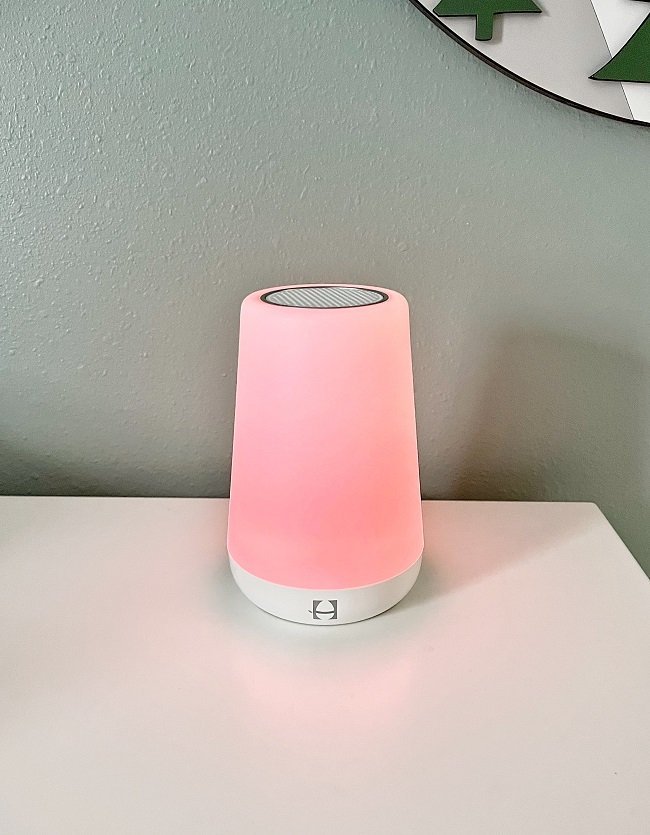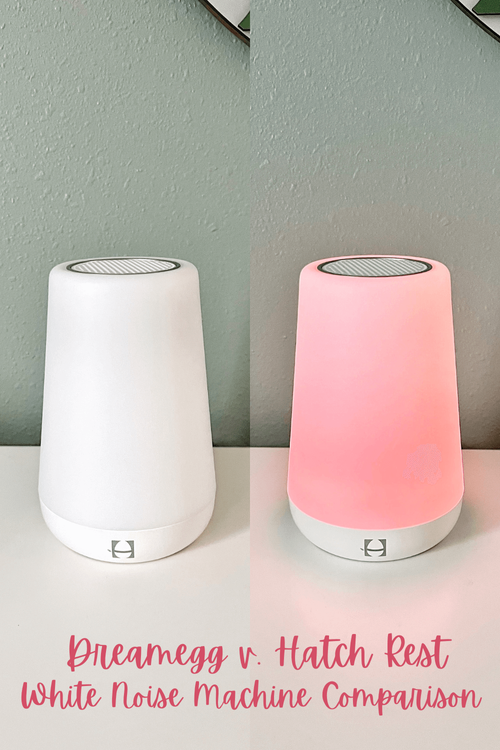Dreamegg vs Hatch Rest - White Noise Machine Comparison
Disclaimer: this post may contain affiliate links from various sites, including Amazon. As a member of the Amazon associates program, we earn a small amount from qualifying purchases when you use our referral link. This does not add any additional cost to you and helps with the expenses of keeping in Life and Littles up and running.
I was never someone who used a white noise machine to fall asleep - that was until I was pregnant! I used to fall asleep to the TV every night (I know, it was a horrible habit) but when I was pregnant I found that I could not turn my mind off and instead of drifting off to sleep within half an hour , I was sitting up for hours on end adding to the pregnancy exhaustion. My husband was the one who suggested we try white noise instead. We have an Apple TV so he would use the Youtube app to play dark screen rain sounds, waves, jungle noises, etc. and while it took me about a week to get used to I realized quickly that once I did fall asleep I slept much more soundly with the white noise. According to my husband, I was much more pleasant to sleep next to (less kicking and tossing) so it was a win for everyone!
When we began prepping for Eli’s arrival we knew that we were going to be using the SNOO Bassinet, which uses white noise in addition to the motion to soothe the baby, so we wanted to make sure that we had a white noise machine for his nursery to assist with his transition from the SNOO to his crib. There are plenty of white noise machines on the market, and wading through all of the research on which is the best can be overwhelming. After doing some research we narrowed our white noise machine choices down to the Hatch Rest or the Dreamegg White Noise Machine. Here are the things that we considered and why the HATCH REST White Noise Machine was the winner for us.
Functionality
As I said, there are A LOT of white noise machine options on the market right now. I knew that I was planning to nurse, which meant late-night feeds in the nursery, so I quickly narrowed the field down to white noise machines that also offered a nightlight function; The Dreamegg and the Hatch Rest.
The Dreamegg is a short, round speaker, with a small light ring that surrounds the top of the machine. The Dreamegg has 7 buttons around the top of the machine that allow you to control the sound, volume, and light. The
Dreamegg D1
comes with one color warm night light while the Dreamegg D1 Pro allows you to adjust the light brightness via one of the buttons. The Dreamegg offers 29 soothing sound options to choose from.
The
Hatch Rest
is a taller, cylindrical speaker that is made almost entirely of night light. There is a small metal ring on the top of the speaker that controls the machine. One tap on the ring will turn on the machine to its last used settings. Each tap after that will cycle through your favorite settings and one long press on the ring turns off the machine completely. The Hatch offers 11 sound options, 10 light pre sets, and an app that allows you to customize your light color if you don’t like the pre-sets.
Design
The Dreamegg is made of hard, opaque plastic. The Dreamegg D1 and D1 pro come in 4 colors (white, blue, black, and wood) so you can choose which color best suits your nursery. I think that the overall design of the speaker looks sleek and modern, and the small size makes it easy to fit seamlessly into any nursery.
The Hatch Rest is made of semi-translucent plastic, so when the light is off the entire machine appears white, but when the light is on it takes on the color of the night light you choose. If you’re wanting to add something extra to your machine to match your nursery Hatch offers 12 different “coverlets” in designs like dinosaurs, unicorns, and woodland creatures.
Additional Features
When looking into these machines there are so many features to take into consideration. They have so many similarities, but what sets them apart?
Mini Versions: If you’re someone who travels often, or if you’re working with a small space, both the Hatch and Dreamegg offer “mini” versions. The Hatch Mini is a smaller profile, round speaker that offers 8 different sleep sounds, but does not offer any nightlight functions. The Dreamegg D11 is a small round speaker that offers 11 sleep sounds, a soft night light, and a child-safe clip that allows you to attach the speaker to a car seat or pack n play while you travel.
Time-to-Rise: One of the biggest differences between the Hatch and the Dreamegg is the Hatch App and the ability to create schedules. You can schedule your machine to turn on the same sound and same light settings at the same time every night during your bedtime routine (one less thing to remember!) You can also use the Time-to-Rise function to help teach older kiddos when it is time to leave their room and when they should play quietly in their room (“Red means Stay, Green means Go”).
Audio Monitor: Hatch recently released the Hatch Rest+ which includes a new feature, a built-in two-way audio monitor, so you can hear into your child’s room without needing another monitor. Through the Hatch app, you will be able to listen into your child’s room, or press to speak through the speaker. To utilize this feature your Hatch and your phone must be connected to the same WiFi. If you currently have a WiFi monitor that lets you check in on your little one when you’re away from home, this will not allow for that but is still a nice added upgrade.
Cost
Always one of the biggest considerations when making any purchase is the cost. Both machines can be ordered on Amazon or picked up locally at Target. One of the nice things about a white noise machine is that once you purchase it, there shouldn’t be any additional costs associated (unless you want to buy any coverlets for the Hatch).
The price of both machines, Hatch Rest ($69.99) and the Dreamegg D1 Pro ($49.99), are fairly comparable but the Hatch does cost a bit more in general for it’s comparable pieces to the Dreamegg line. If you’re interested in the audio monitor function that the Hatch Rest+ offers, it is slightly more expensive at $89.99. The Hatch Mini costs $39.99 while the Dreamegg D11 is a slightly cheaper $29.99.
THE WINNER
After considering all of the pros and cons of both machines, and asking a few friends about their experiences, we decided to go with the Hatch Rest. Ultimately, the biggest feature was the Time-to-Rise and scheduling abilities. I love that there is one less thing for me to think about during our bedtime routine and now my son knows as soon as his light comes on that it’s time for pajamas. When E was small, and his nap schedule was slightly more chaotic, I liked that I could use one finger to turn on his white noise machine while holding a half-sleeping baby. The last feature that I didn’t realize we would use as often as we have is the lighting and volume control through the app. If my husband and I are trying to watch a movie after bedtime, or the spring thunderstorms are louder than usual we can easily turn the volume on his white noise without having to touch the machine!
Don’t worry! Hatch also has parents covered, if you like to sleep with white noise, Hatch makes the Hatch Restore which includes the night light, white noise and Time-to-Rise functions. We purchased one for my in-laws for Christmas and they absolutely love it.







